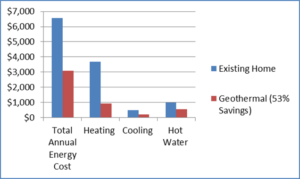This post is part of a series on energy consumption and conservation. For other posts in this series please click here.
We previously discussed home heating and cooling, and the role they both play in our overall energy consumption. Aside from the steps you can take to lower you heating/cooling bill, you can also choose to invest in a version of home temperature control that uses significantly less electricity compared to conventional heating and cooling systems : geothermal.
Below is a brief description of what geothermal power is and how it can be applied in your household:
[1]Geothermal heat pumps (GHPs), sometimes referred to as GeoExchange, earth-coupled, ground-source, or water-source heat pumps, have been in use since the late 1940s. They use the constant temperature of the earth as the exchange medium instead of the outside air temperature. This allows the system to reach fairly high efficiencies (300% to 600%) on the coldest winter nights, compared to 175% to 250% for air-source heat pumps on cool days. Although many parts of the country experience seasonal temperature extremes — from scorching heat in the summer to sub-zero cold in the winter—a few feet below the earth’s surface the ground remains at a relatively constant temperature. The GHP takes advantage of this by exchanging heat with the earth through a ground heat exchanger. Even though the installation price of a geothermal system can be several times that of an air-source system of the same heating and cooling capacity, the additional costs are returned to you in energy savings in 5 to 10 years. System life is estimated at 25 years for the inside components and 50+ years for the ground loop.
According to the EPA, geothermal heat pumps can reduce energy consumption — and corresponding emissions — up to 44% compared with air-source heat pumps and up to 72% compared with electric resistance heating with standard air-conditioning equipment. GHPs also improve humidity control by maintaining about 50% relative indoor humidity, making GHPs very effective in humid areas.
Though the installation of a GHP system can be expensive, the savings you can expect, even over the first year following application, are substantial.
*The chart at left is based on an average 2,700 sq. foot home in the Pittsburgh, PA area. Utility rates were provided by the U.S. Energy Information Administration*
Using the stated home size and utility cost parameters, homeowners could expect a decrease of 50% or more in their annual energy costs. The average geothermal heating system costs $20,000 to $25,000 to install, depending on the type of system you choose.
For a more in-depth description of the different types of GHP systems, click here.
While that is a substantial initial investment, using the chart above we can determine full return on investment in 6-8 years with the savings accrued. From there on out, it’s money in the bank, as they say. In addition to the savings felt in heating bills, the federal government also offers 50 individual tax incentive programs for homeowners who employ high-efficiency technologies at home. The full list can be found here.
The initial investment is sizeable, but as we have learned, the payoff in the long run can be well worth it.
[1] “Geothermal Heat Pumps.” Energy.gov. U.S. Department of Energy, 24 June 2012. Web. 20 Apr. 2015.


